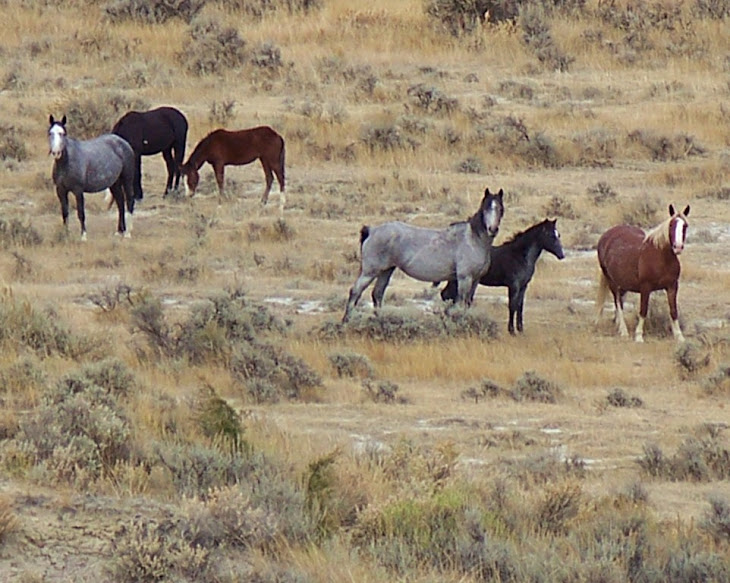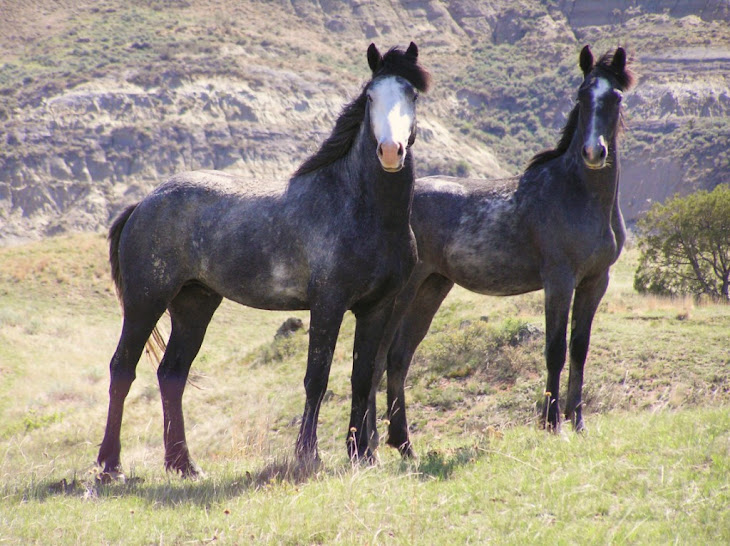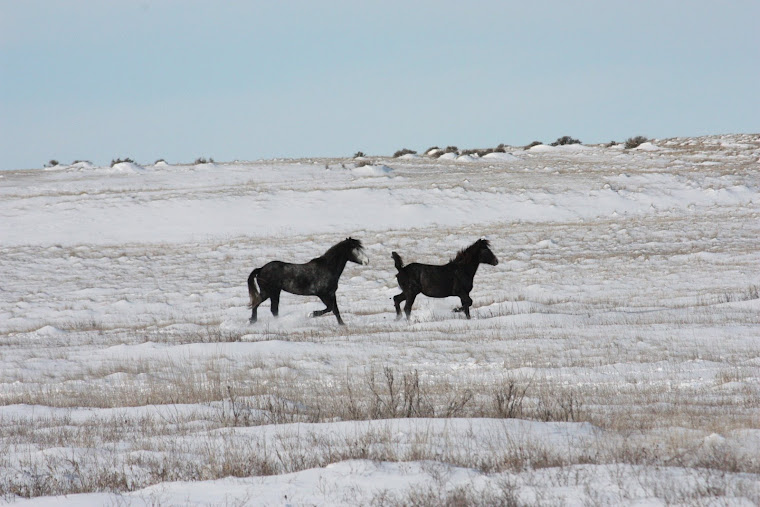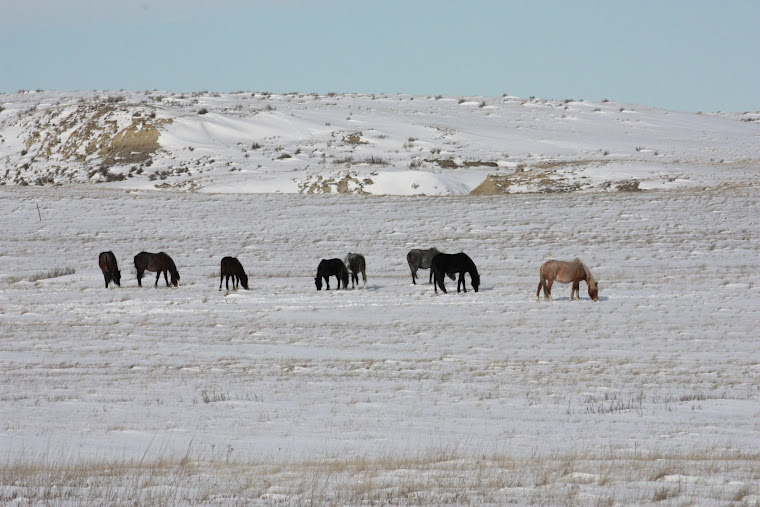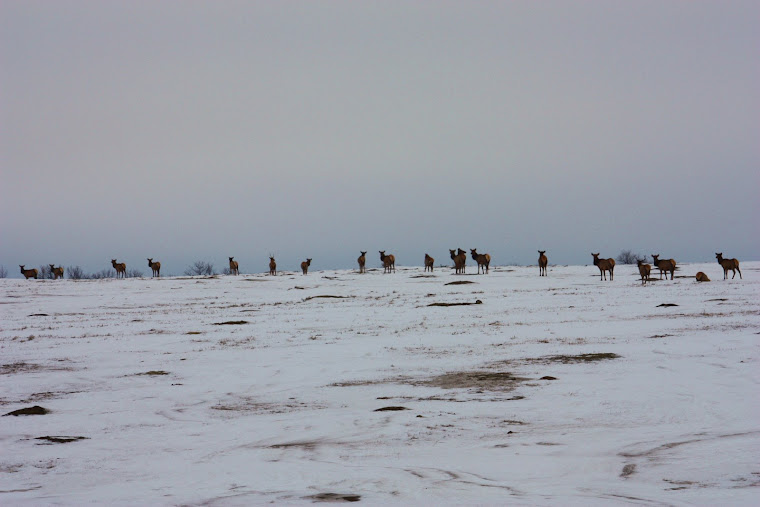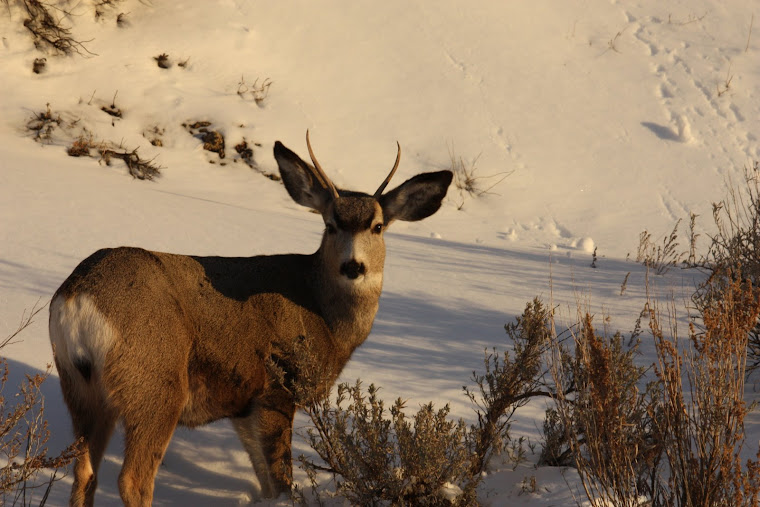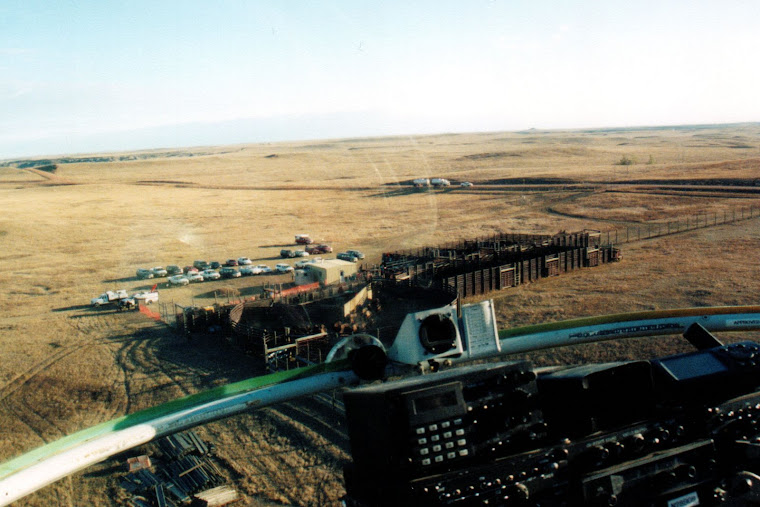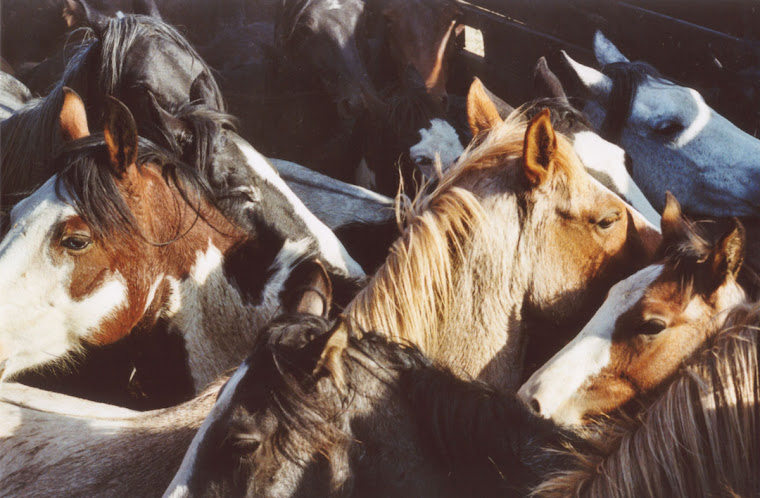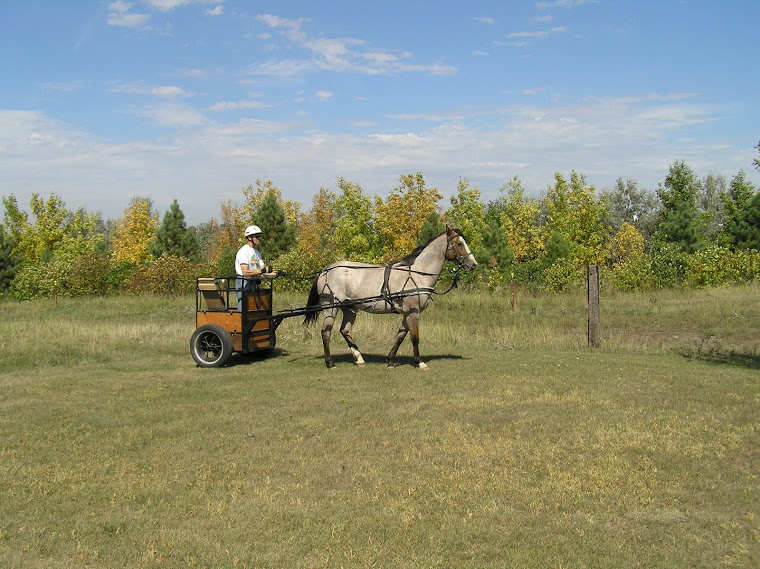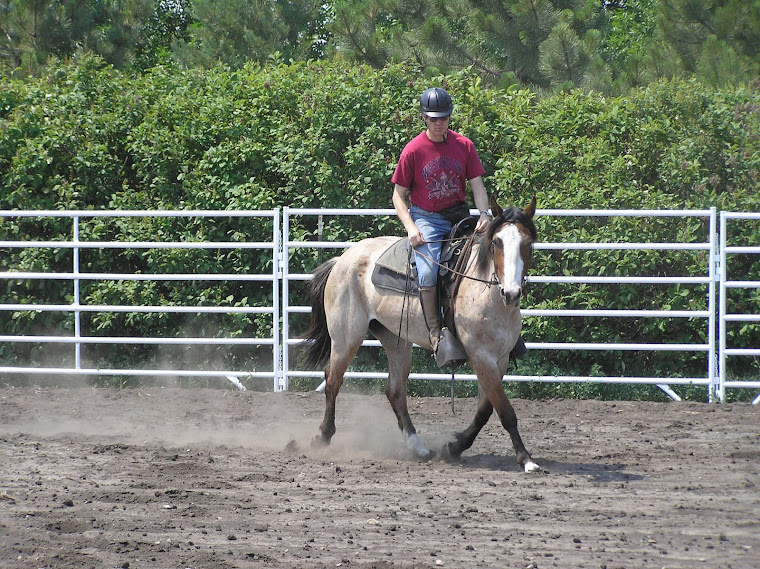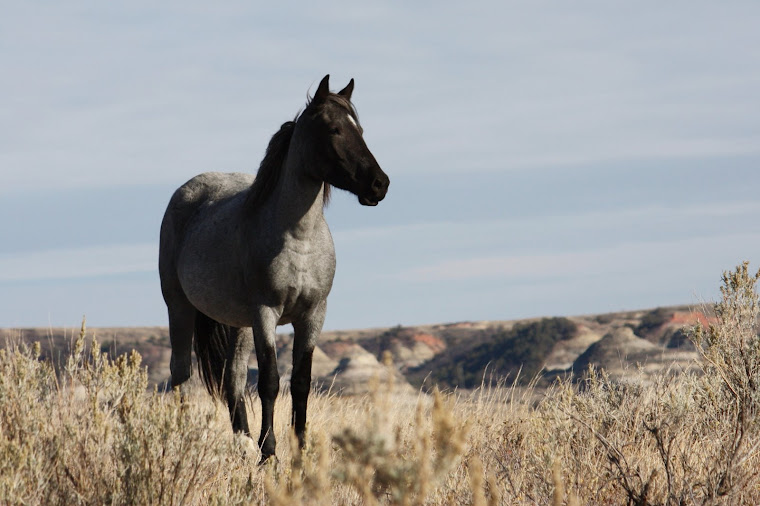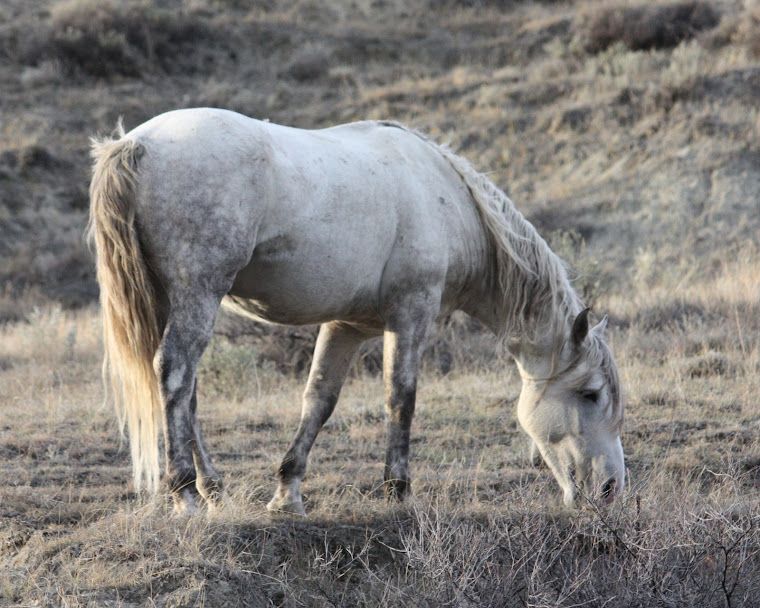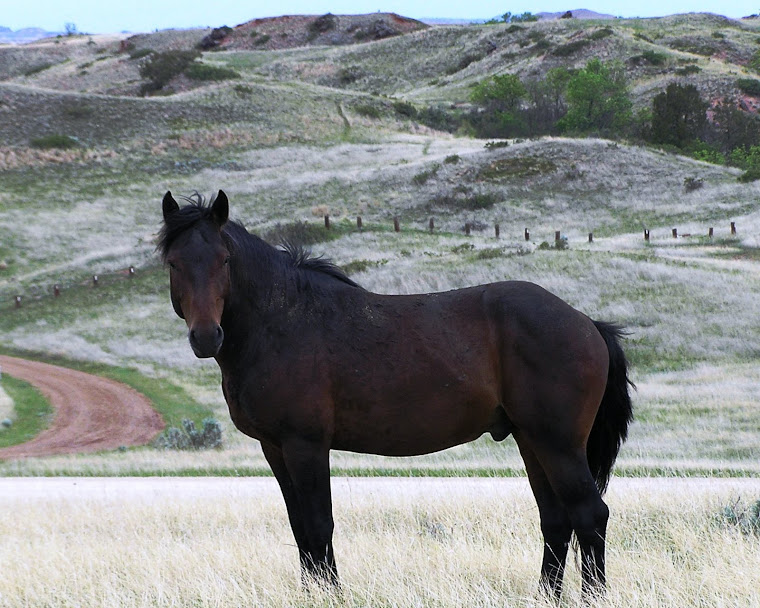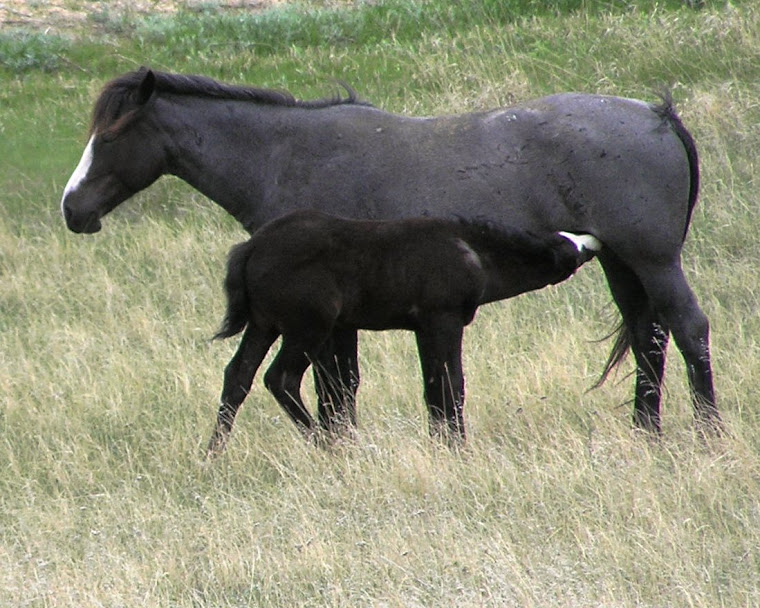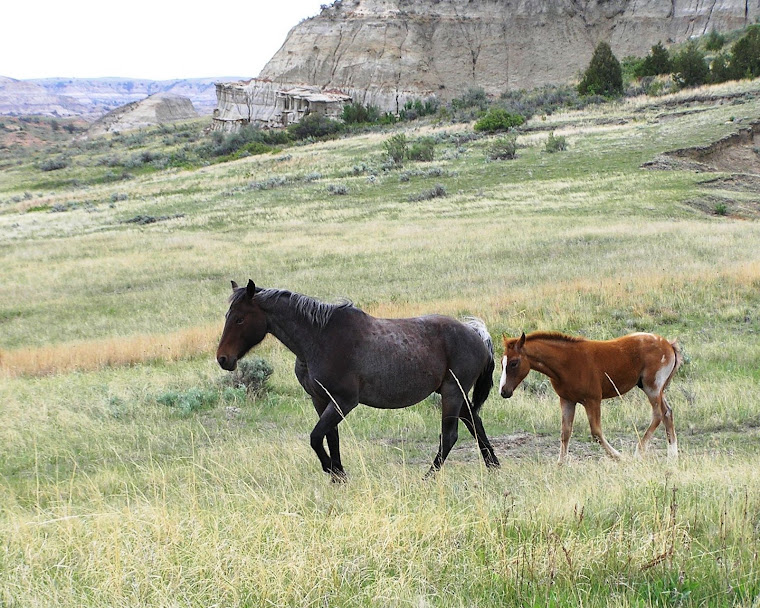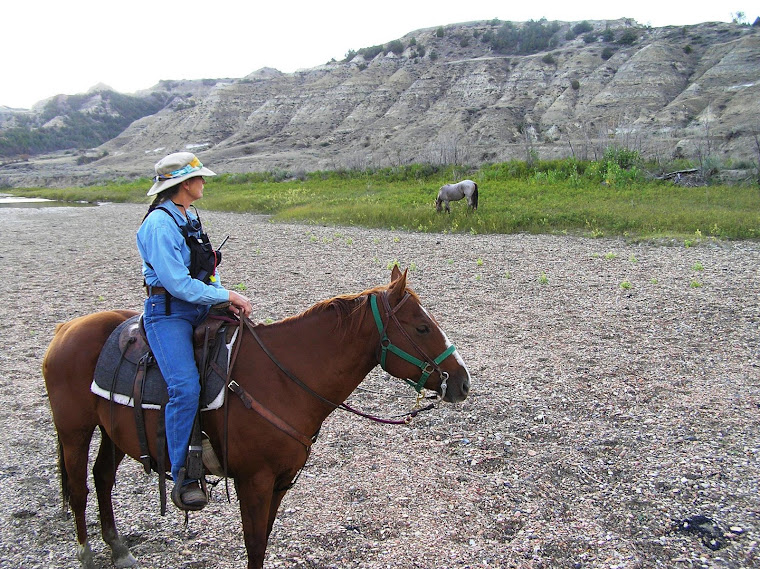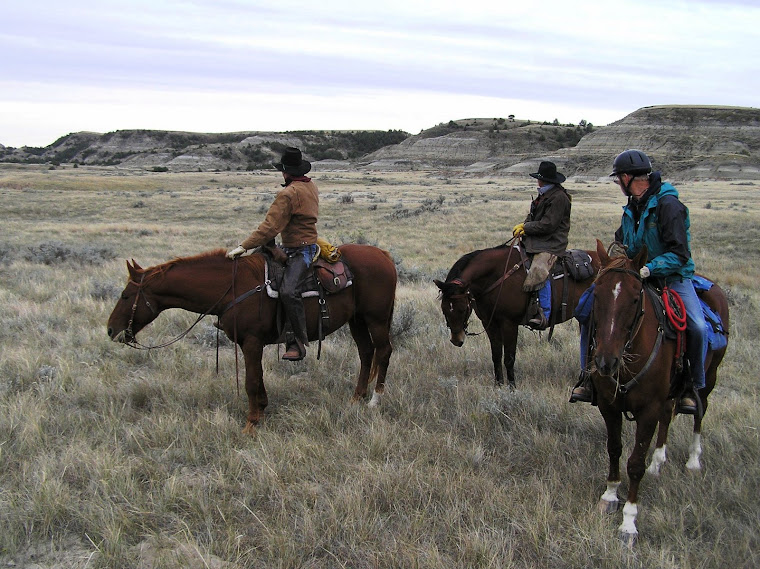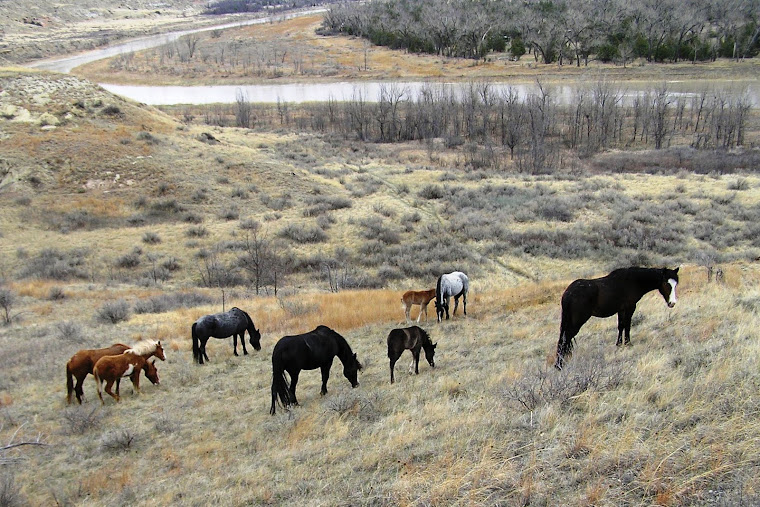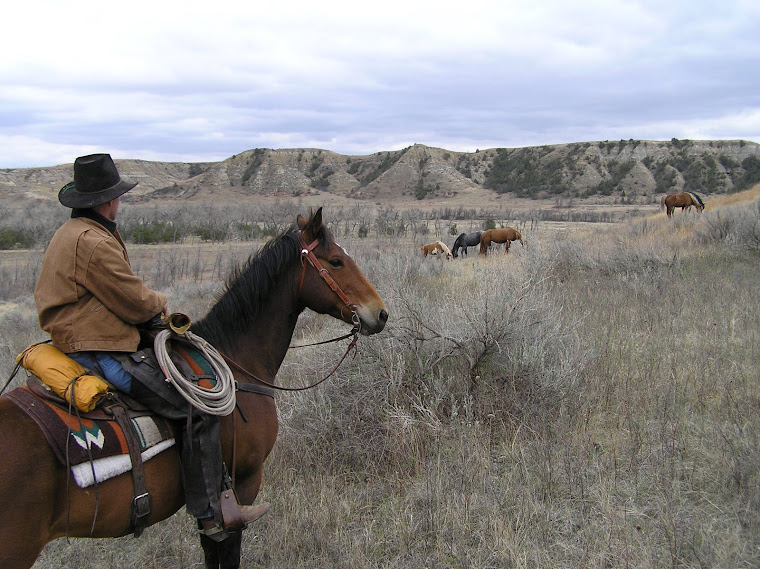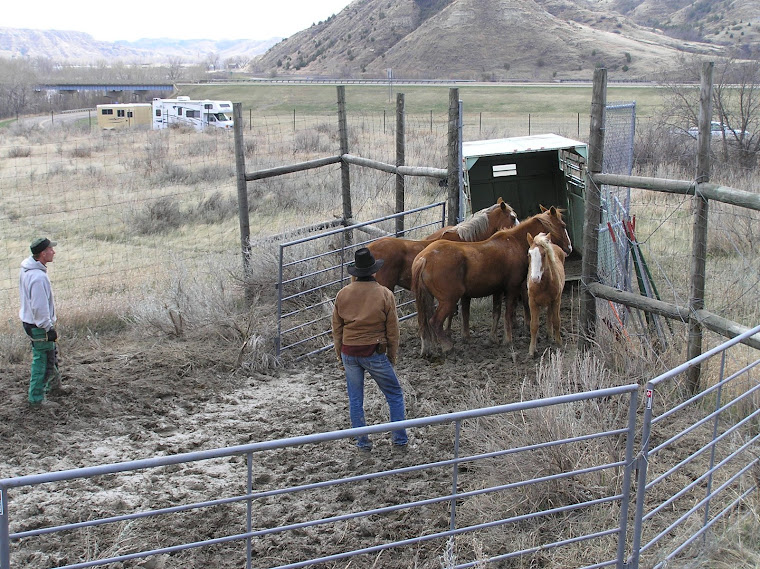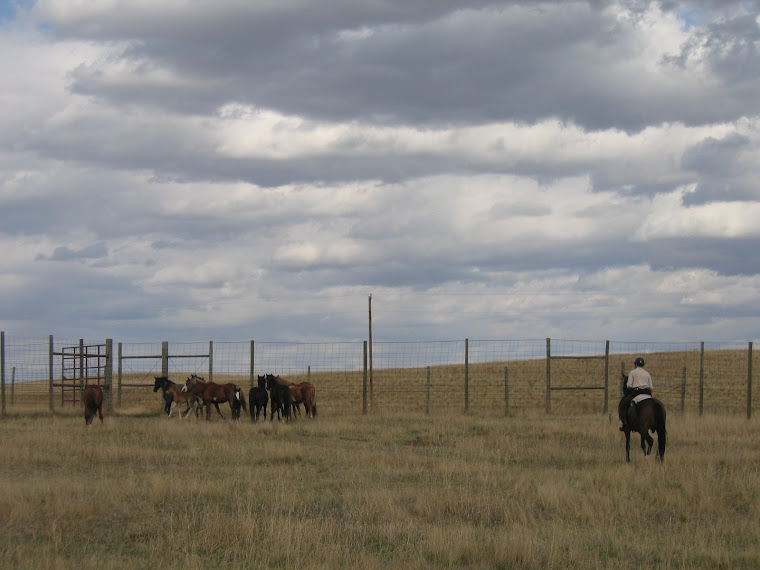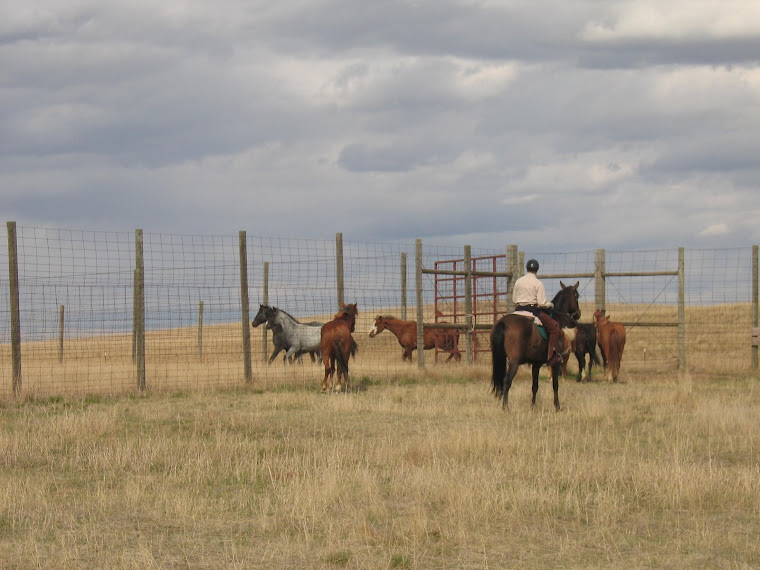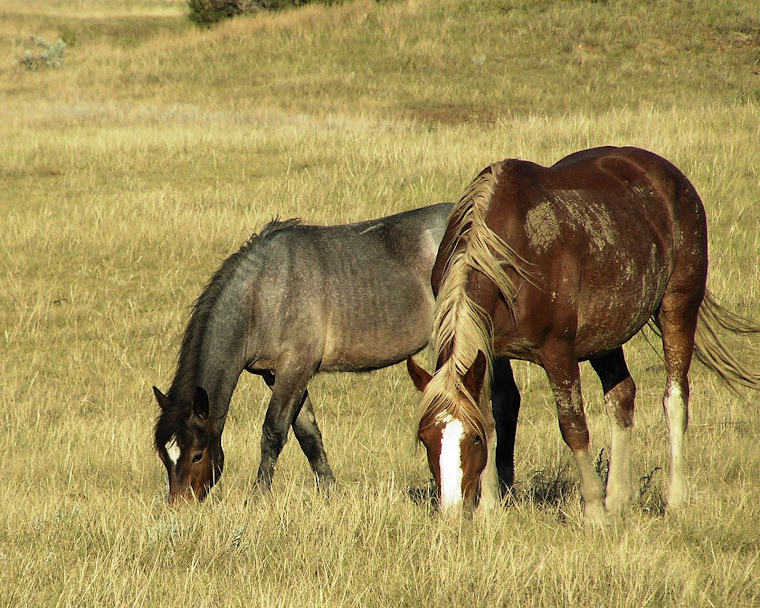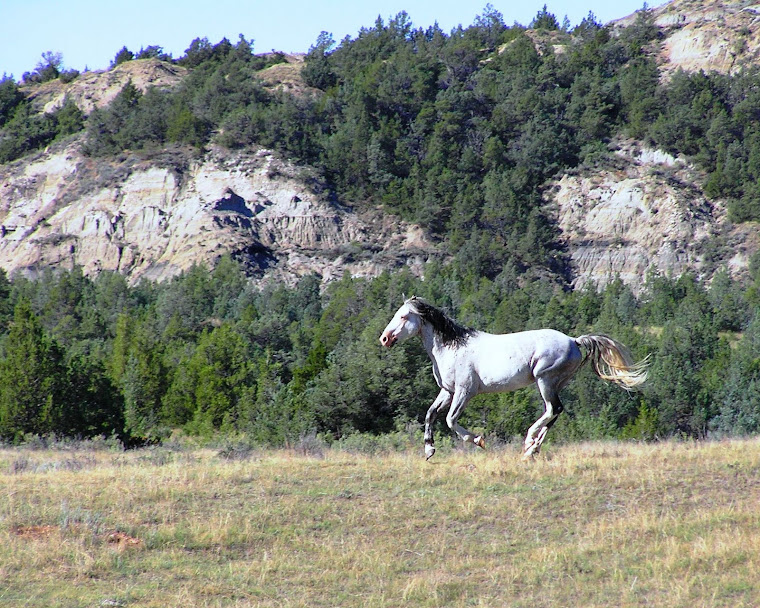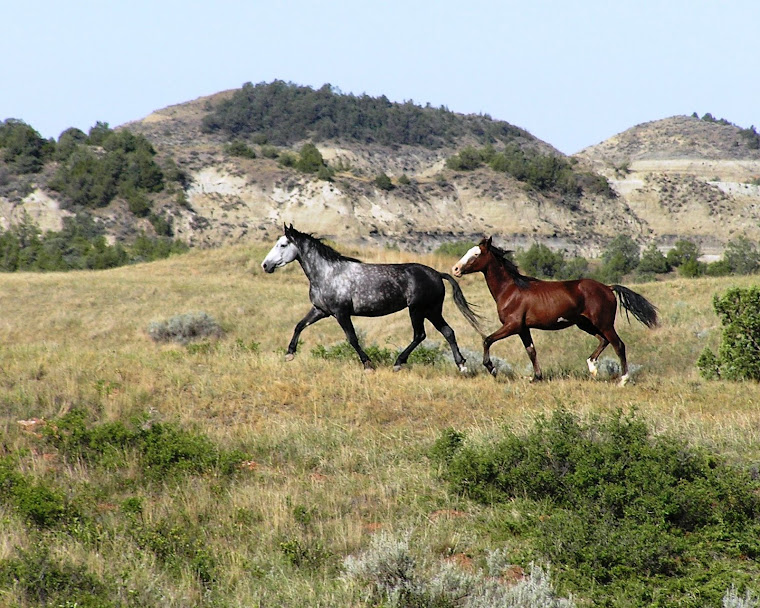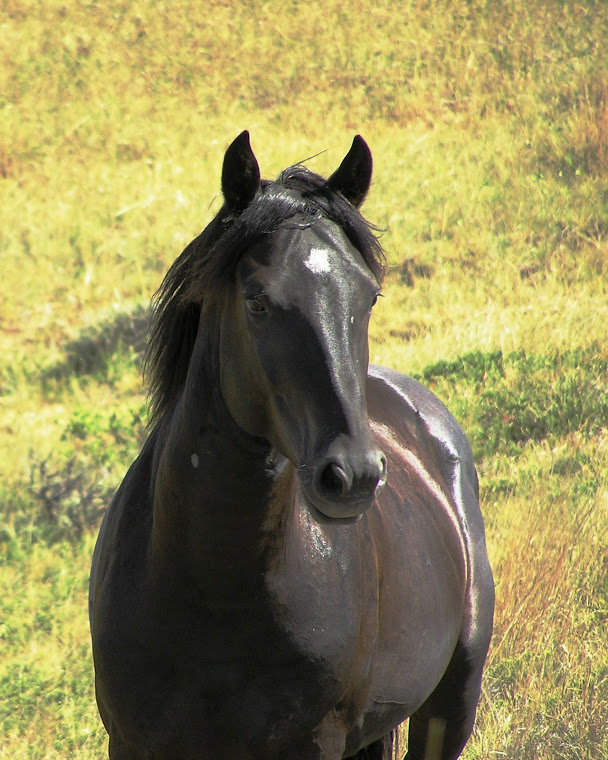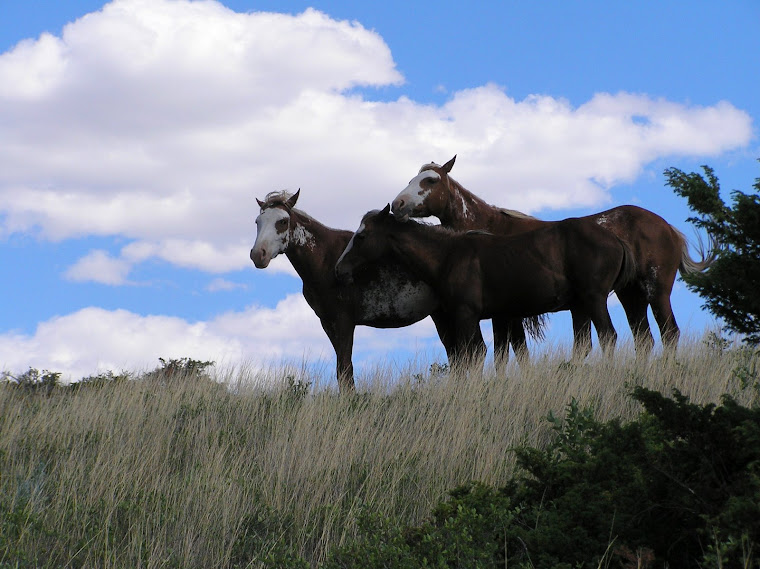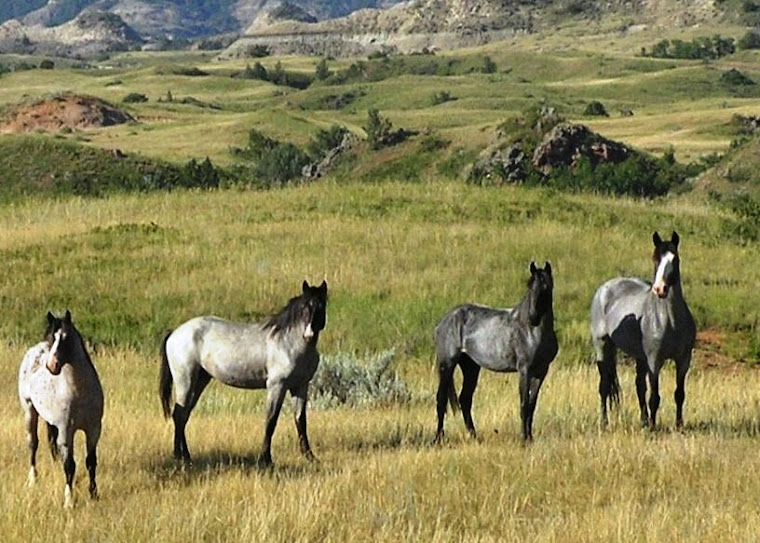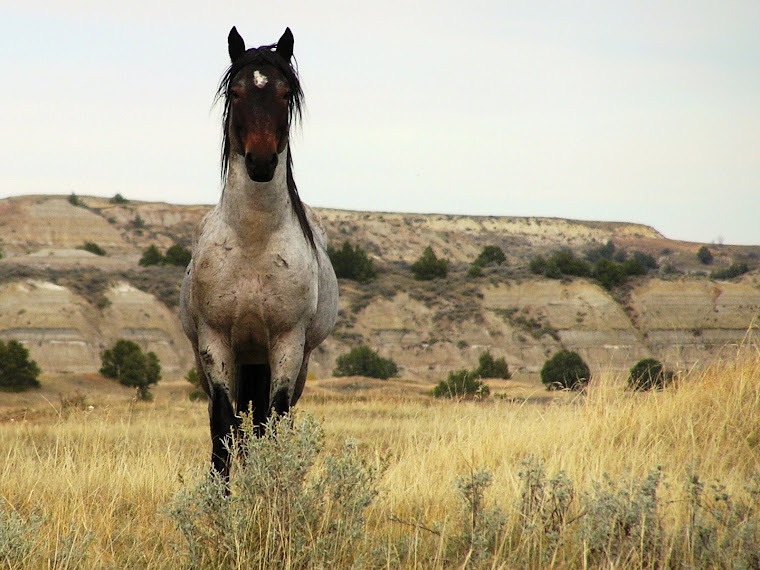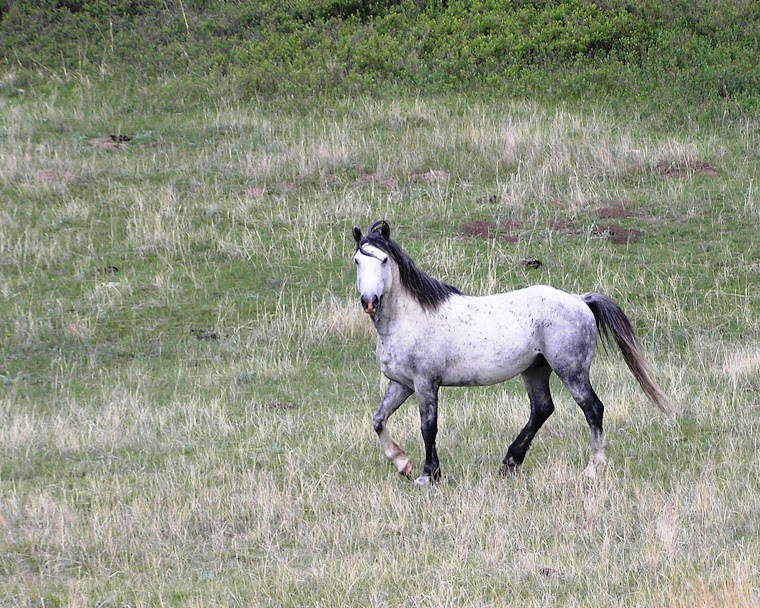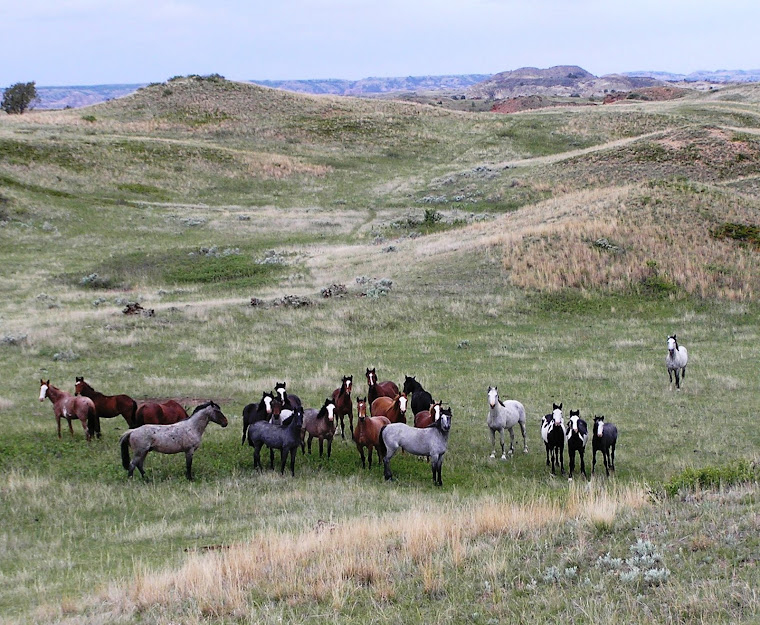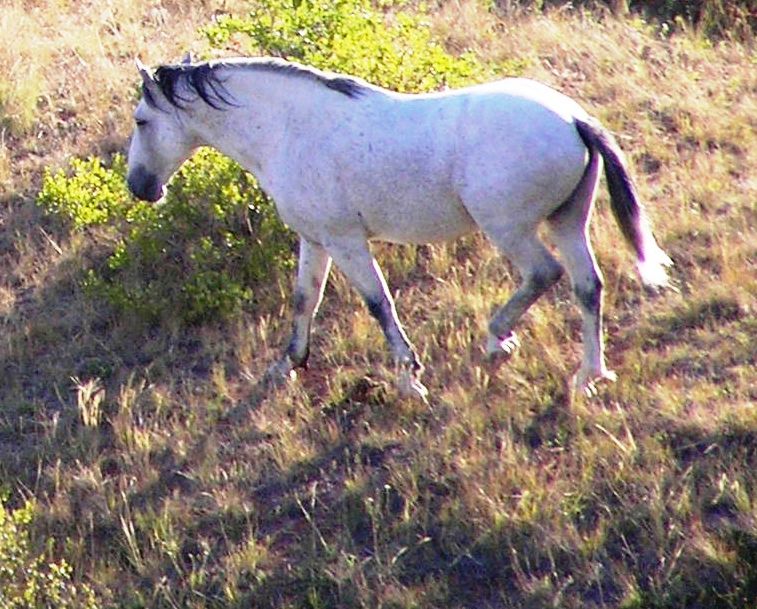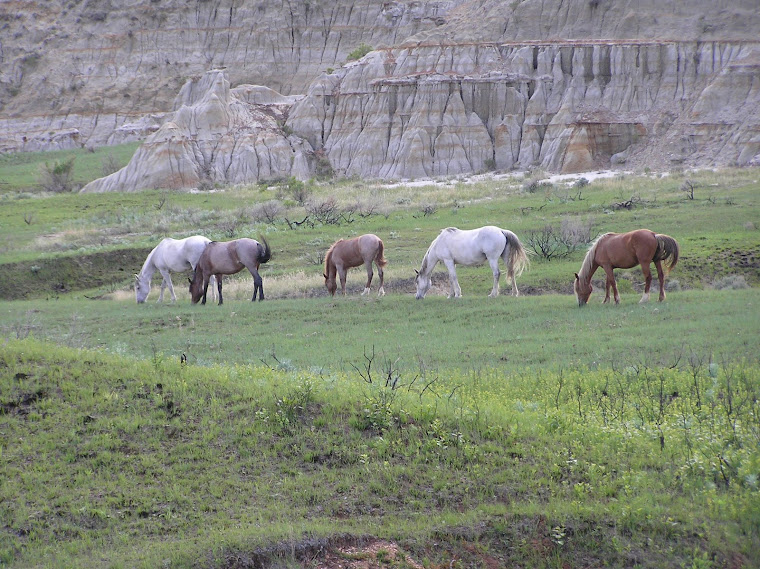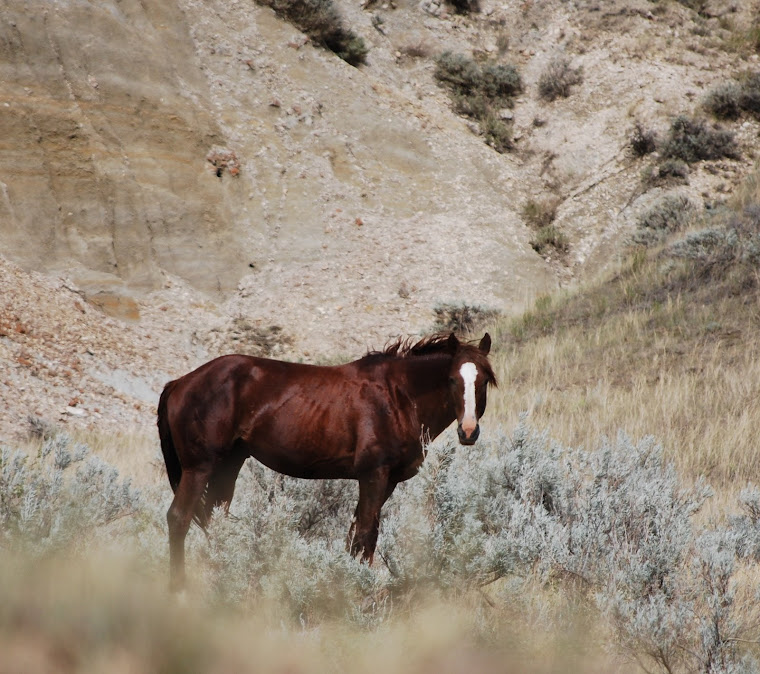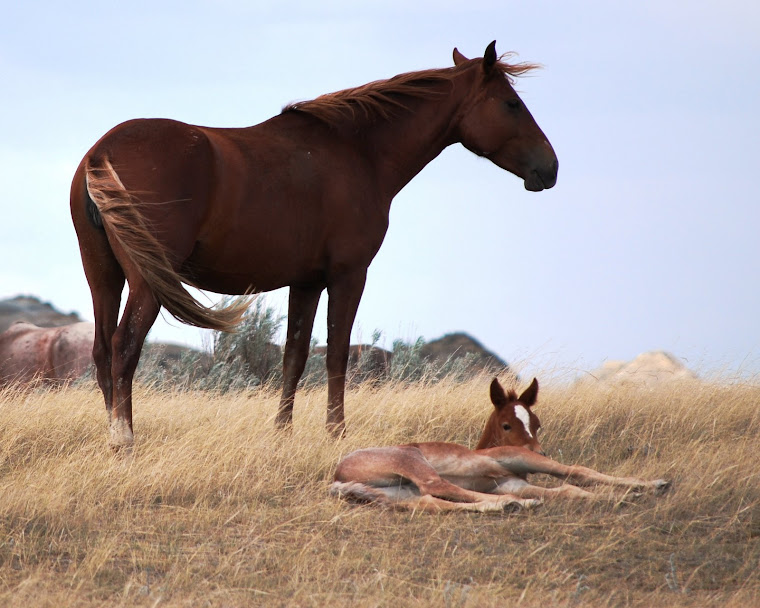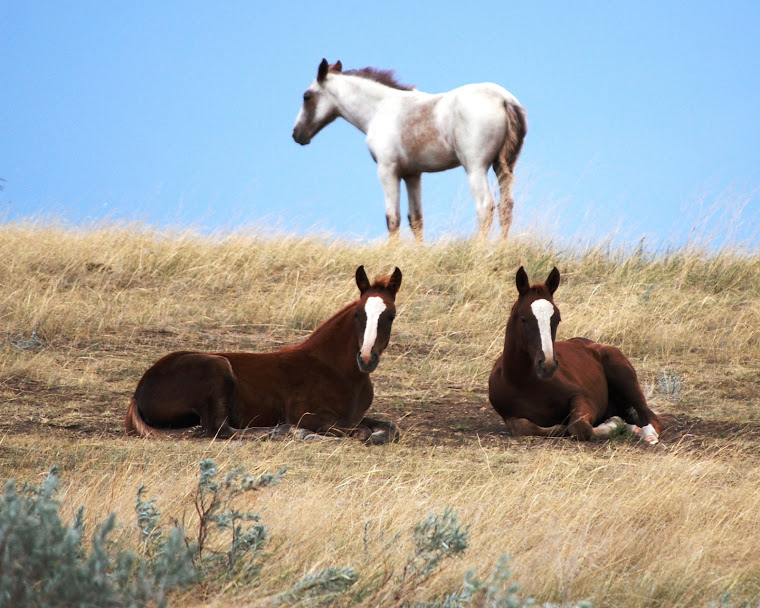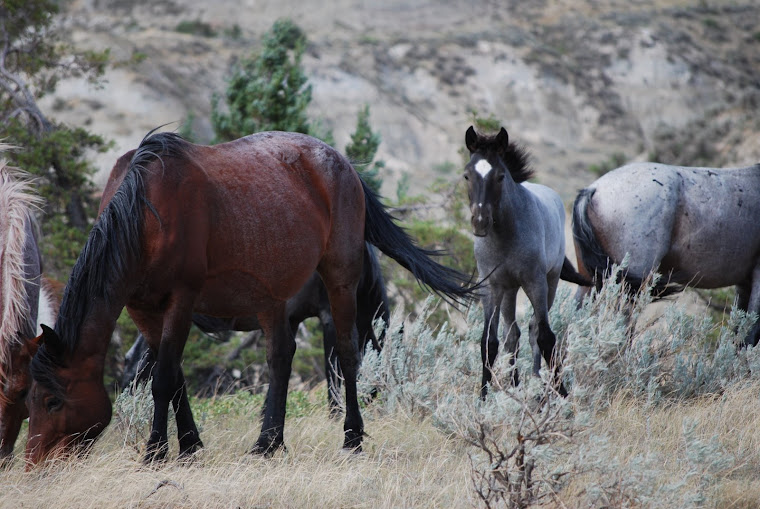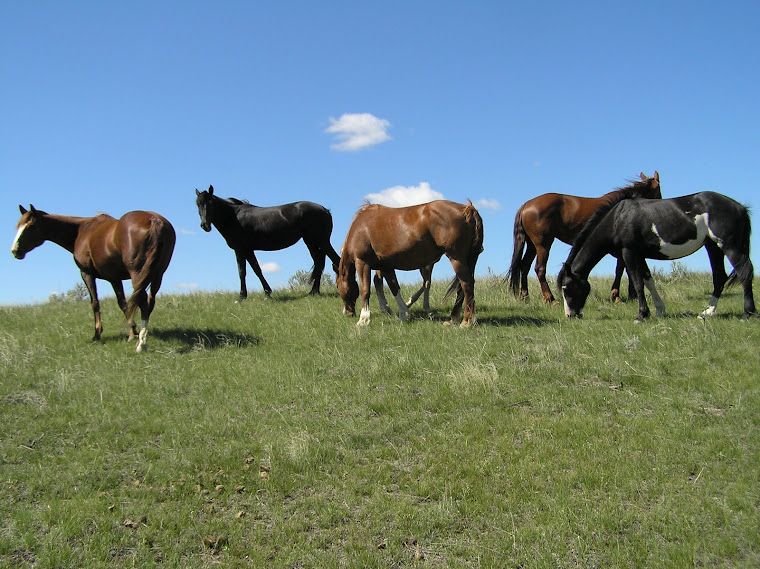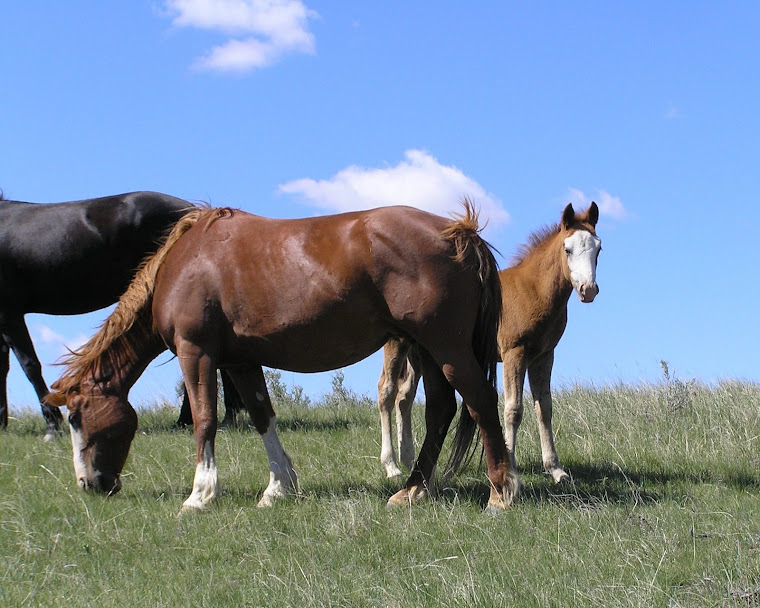June seems to be a good month for foaling, though, with the number of young, maiden mares, we have lost some. As the earlier foals mature, some of them are revealing their true color. Many of the foals born sorrel are now turning red roan, many born bay are now turning bay roan, and some of those that appeared to be black are becoming blue roans. The color patterns and how they develope would be a study in itself, but that isn't our focus. We can just speculate on which ones will change and what color they will turn out to be.
Auney, our first foal, has become a pretty red roan, as has one of our favorites, Roosevelt. At first we felt sorry for Roosevelt because he had no one his age to play with, but that hasn't held him back. Just like his namesake, he has learned to play with the big boys. He and his half brother, Charlie have become fast friends and spend a lot of time together playing like big stallions or resting in the sandy banks on Boicourt.
Buck, who was born a bay, is now showing the white that will, at some time in the future, blend with his dark bay coat to create at rich bay roan. His little brother, Rasmusson, was born red roan. His color was easy to predict, his gender was not. For the first several days, we called him a filly because the new foals have their hind quarters tucked under so much that it is hard to determine what they are. Once they are a few weeks old, it is no longer a problem.
The six foals in the Red Face and Singlefoot bands have a new baby sister. The overo mare, Lightning, had a cute overo filly who looks a lot like mama. We are hoping that she stays black like her mama and doesn't gray like her sire, Singlefoot.
Beauty, in Embers' band, looks as if she will be a blue roan to begin with, but most of her siblings have eventually turned gray like Bella. With graying, we will only know over time, since any color can gray. Little Rue, Neuens, Mosser, Little Mo, Barnhart, Roxie, Connolly, and Schaffer were all born dark. Time will tell whether they will roan, turn black or gray. Only Connolly, or as Hedrick calls her, Cocoa Puff, shows the telltale signs of roaning, a lighter underbelly and white at the top of her tail.
Rue has been a puzzling little filly. She seems to have been born missing a large patch of hide over her left shoulder. It was an ugly wound when we first saw her, but it didn't seem to bother her at all. Over the weeks it has filled in and healed. She seems to be doing very well, so there is no reason to believe that it will cause any problems in the future. Marquis, from High Star's band, has to be my favoite, but he too is difficult to predict for color. since his sire is balck and his dam, light red roan, he has many options. I am prediction he will be a bay roan, but for now, I am calling him a buckskin.
Some of the foals have been difficult to get a good photo of, but as we continue the behavior study we will try to get good photos of them all. It is highly likely that all of them, along with the one and two year olds, will be sold in the fall, so I will try to have all of the horses that may be sold pictured on this blog by October.
Thursday, June 25, 2009
Tuesday, June 23, 2009
HAZARDS
Horse tracking is definitely not without hazards. Spending eight hours a day outdoors is just what many of us consider a dream job, but some of the the situations we have encountered have been difficult or down right dangerous.
Jan and I had been tracking together for several days when we again found Mystery. Mystery was one of our old reliable stallions, who could usually be counted on to be in his familiar territory and therefore, not too hard to find. We had done several behavior observations of him and his four mares. Unfortunately Gray Lady was dry this spring and both Shale and Lacey had lost their foals, so the majority of our observations were the more boring feeding and resting.
This particular day we found them, later on a cool afternoon, resting by a small clay butte just northwest of Buck Hill. Near a small water pond on the way to the butte was an old lone bison bull. We gave him a cautious eye and plenty of space as we passed the pond. Generally lone bulls are harmless as long as they don't feel threatened and we were not interested in making him feel uncomfortable.
Focusing on the small band and determining how we should approach them, I soon pushed the bull out of my mind. We were about to settle ourselves on a small rise several yards from the band when Jan noticed that the bull had followed us; he was now grazing a few yards away. Thinking he was just following the trail away from the pond, we moved away to where we would leave him clear access to the trail. Again I focused on the band, but Jan was not so easily distracted. Within minutes he had circled the small rise and closed the distance between himself and us to about twenty feet. That was enough to convince us that we needed to put some distance or something substantial between us and the curious beast with the huge woolly head and menacing horns.
Where could we go that a bull bison couldn't follow us with unbelievable speed and agility? Nowhere, but we high tailed it to the nearest small butte anyway. It made us feel a little better to have that butte available to scamper up if we needed some height advantage, even though we knew he could get to the top faster than we could if he really wanted to. We were hoping he didn't want to!
He seemed to understand that he had sufficiently spooked us, so he proceeded on to the other butte to spook our band. They quickly followed our lead and moved on to a less popular hill while the old bull stopped to scratch on the butte. We could almost detect a swagger in his walk as he moved off to graze nearby. We got to finish our observation, but we kept an eye on our intruder, having gained a better understanding of why the schoolyard intimidator is called a "bully"!
Back in the Park in early June, we woke one morning to another unexpected intruder in our quest to find and observe the horses. It was June 6th in southwestern North Dakota, and it was snowing. Having lived in North Dakota more years that I like to admit to, I had never before seen snow in June, but there it was, coming down in huge clusters. At first we thought it would melt immediately when it hit the ground, which it did. But, it just kept coming, and coming, until the ground was covered. We decided to brave the now slippery loop road and go around the Park anyway. Maybe we would see some poor miserable horses hanging along the road, hoping to gain some warmth that may have remained in the blacktop. Well, we never saw a horse, not one, but we got some great photos of a phenomenon that we may never see again. I had to snap a photo of our young friend, Hedrick, from North Carolina, shivering in the cold.
Our last hazard we found on a much warmer day. We had been seeing several bands from Boicourt Ridge so we headed back out toward the north from the overlook. There on the bottoms, north of the ridge and tucked into a secluded valley, were Embers, High Star, and Cocoa. Since we had seen a carcase that we thought we should investigate near the fence, we walked all the way down to the north fence. It was only a large bison, but at least we knew it wasn't one of our missing horses. When it was time to go back we took a vote as to whether we should walk around the butte and up an easier valley or take the shorter route but have to climb the high, steep north face of the ridge. Hedrick voted the low road and I voted the high road, making it Henry's decision which way to go. That way we could blame him for a long walk or a steep climb, either contributing to the tired condition of our bodies.
He voted the low road, so we took off for the prairie dog town on what the Boicourts called Pleasant Flat. ( A future post will feature the information I was given about this adventurous family.) Plodding across the prairie dog town, we weren't paying much attention to where we were going as we pondered what it would be like to live on that flat 100 years ago. Suddenly Hedrick took a little longer step and exclaimed, "There's a snake in that hole!" Oh, there was a snake in the hole, all right. It was a fat coiled rattle snake at the mouth of the prairie dog den. Getting a photo of him was challenging since there was a lot of vegetation in front of him and Henry was not interested in clearing it away for me. He did oblige to throw a rock at the snake to prove it was indeed a rattler. The snake was was not too pleased with us interrupting his nap and having a rock tossed at him didn't improve his disposition. We decided it would be wise to pay a little more attention to where we were putting our feet from now on.
Having convinced us of it's power to change our plans, nature prevailed over the puney quests of man.
Jan and I had been tracking together for several days when we again found Mystery. Mystery was one of our old reliable stallions, who could usually be counted on to be in his familiar territory and therefore, not too hard to find. We had done several behavior observations of him and his four mares. Unfortunately Gray Lady was dry this spring and both Shale and Lacey had lost their foals, so the majority of our observations were the more boring feeding and resting.
This particular day we found them, later on a cool afternoon, resting by a small clay butte just northwest of Buck Hill. Near a small water pond on the way to the butte was an old lone bison bull. We gave him a cautious eye and plenty of space as we passed the pond. Generally lone bulls are harmless as long as they don't feel threatened and we were not interested in making him feel uncomfortable.
Focusing on the small band and determining how we should approach them, I soon pushed the bull out of my mind. We were about to settle ourselves on a small rise several yards from the band when Jan noticed that the bull had followed us; he was now grazing a few yards away. Thinking he was just following the trail away from the pond, we moved away to where we would leave him clear access to the trail. Again I focused on the band, but Jan was not so easily distracted. Within minutes he had circled the small rise and closed the distance between himself and us to about twenty feet. That was enough to convince us that we needed to put some distance or something substantial between us and the curious beast with the huge woolly head and menacing horns.
Where could we go that a bull bison couldn't follow us with unbelievable speed and agility? Nowhere, but we high tailed it to the nearest small butte anyway. It made us feel a little better to have that butte available to scamper up if we needed some height advantage, even though we knew he could get to the top faster than we could if he really wanted to. We were hoping he didn't want to!
He seemed to understand that he had sufficiently spooked us, so he proceeded on to the other butte to spook our band. They quickly followed our lead and moved on to a less popular hill while the old bull stopped to scratch on the butte. We could almost detect a swagger in his walk as he moved off to graze nearby. We got to finish our observation, but we kept an eye on our intruder, having gained a better understanding of why the schoolyard intimidator is called a "bully"!
Back in the Park in early June, we woke one morning to another unexpected intruder in our quest to find and observe the horses. It was June 6th in southwestern North Dakota, and it was snowing. Having lived in North Dakota more years that I like to admit to, I had never before seen snow in June, but there it was, coming down in huge clusters. At first we thought it would melt immediately when it hit the ground, which it did. But, it just kept coming, and coming, until the ground was covered. We decided to brave the now slippery loop road and go around the Park anyway. Maybe we would see some poor miserable horses hanging along the road, hoping to gain some warmth that may have remained in the blacktop. Well, we never saw a horse, not one, but we got some great photos of a phenomenon that we may never see again. I had to snap a photo of our young friend, Hedrick, from North Carolina, shivering in the cold.
Our last hazard we found on a much warmer day. We had been seeing several bands from Boicourt Ridge so we headed back out toward the north from the overlook. There on the bottoms, north of the ridge and tucked into a secluded valley, were Embers, High Star, and Cocoa. Since we had seen a carcase that we thought we should investigate near the fence, we walked all the way down to the north fence. It was only a large bison, but at least we knew it wasn't one of our missing horses. When it was time to go back we took a vote as to whether we should walk around the butte and up an easier valley or take the shorter route but have to climb the high, steep north face of the ridge. Hedrick voted the low road and I voted the high road, making it Henry's decision which way to go. That way we could blame him for a long walk or a steep climb, either contributing to the tired condition of our bodies.
He voted the low road, so we took off for the prairie dog town on what the Boicourts called Pleasant Flat. ( A future post will feature the information I was given about this adventurous family.) Plodding across the prairie dog town, we weren't paying much attention to where we were going as we pondered what it would be like to live on that flat 100 years ago. Suddenly Hedrick took a little longer step and exclaimed, "There's a snake in that hole!" Oh, there was a snake in the hole, all right. It was a fat coiled rattle snake at the mouth of the prairie dog den. Getting a photo of him was challenging since there was a lot of vegetation in front of him and Henry was not interested in clearing it away for me. He did oblige to throw a rock at the snake to prove it was indeed a rattler. The snake was was not too pleased with us interrupting his nap and having a rock tossed at him didn't improve his disposition. We decided it would be wise to pay a little more attention to where we were putting our feet from now on.
Having convinced us of it's power to change our plans, nature prevailed over the puney quests of man.
Tuesday, June 2, 2009
THE FIGHTS CONTINUE
Red Face never seems to fail to provide excitement, since he continues to run with Singlefoot and his body guard, Satellite. It is such a curious thing to watch these three stallions maintain their alliances in a cooperative effort to ward off advances from other stallions who try to steal their mares. One could make a complete behavior study just on the dynamics of these three stallions.
Last year Red Face had no foals, leading us to wonder if he was able to settle his mares, but this year every mare he had in his harem foaled a healthy foal. Singelfoot lost two foals last year to unknown causes and only has one this year. Two more of his mares carrying this year's foals have yet to deliver. Though they have been successful in increasing their bands by reproduction, they have each lost mares in the past month. One would think their cooperative effort would make taking their mares more difficult, but Red Face has lost Firefly and her filly, Rue, to Sidekick and Strawberry, her three year old colt, Eclipse, and her new filly, Medora to High Star. Singlefoot has lost Molly and little Teddy Bear to Red Face and Bentonite and Sapphire to Wind Canyon.
On the hottest day of our last visit to the park, Jan and I hiked far into the interior of the park to an area that looks fairly flat from a distance but is laced with deep valleys. We felt it was worth a long hike on a hot day to find four bands in the same area and we wanted to check on Sidekick's little filly, Funny Girl, who was limping badly. We called in Henry and Hedrick, the other observation team, to help us work the larger bands in such rolling country. While they were coming, we were able to work Embers and his band. There was nothing new happening with them.
Moving a little closer to try to get all of Red Face and Singlefoot's bands in sight, we were able to see that Sundance had a solid bay filly with her. We also noticed a lone horse about five hundred yards fr0m the others. With the sun behind her, she looked dark chestnut and had me stumped for a time, but I finally realized it was the young black mare, Lignite. Since she was alone, I figured she must have a brand new foal with her too. Moving a little close yet, I was able to confirm that she had a cute black filly with her that was no more than a few hours old. She had most likely been born some time during the early hours of the morning and they had not yet returned to Red Face's band.
Not wanting me to get too close to the foal, Lignite started back to her band. Sensing an opportunity to steal another mare from Red Face, Sidekick approached her to bring her into his band grazing not too far from the larger band. Red Face was in a small valley and didn't see that his mare was about to be taken, but Satellite did see Sidekick and immediately sensed his intentions. Satellite ran to intervene while Lignite wheeled to try to protect Little Mo from the battle which she knew was about to irrupt. Satellite challenged Sidekick and both horses reared in defiance of one another. Satellite had beaten off Sidekick handily and was about to claim the mare for himself when Red Face showed up. I have never seem Red Face fight Satellite, but it has always been clear that Red Face is dominant over Satellite. Satellite was soon running from Red Face.
Twice more Red Face had to run off Satellite so it appears to be a matter of time before Satellite deserts his post as body guard to Singlefoot and acquires his own harem. It will be interesting who he will take them from. Will it be Red Face or Singlefoot, or will he take on another stallion? Only time and more observations will tell the rest of this story.
Last year Red Face had no foals, leading us to wonder if he was able to settle his mares, but this year every mare he had in his harem foaled a healthy foal. Singelfoot lost two foals last year to unknown causes and only has one this year. Two more of his mares carrying this year's foals have yet to deliver. Though they have been successful in increasing their bands by reproduction, they have each lost mares in the past month. One would think their cooperative effort would make taking their mares more difficult, but Red Face has lost Firefly and her filly, Rue, to Sidekick and Strawberry, her three year old colt, Eclipse, and her new filly, Medora to High Star. Singlefoot has lost Molly and little Teddy Bear to Red Face and Bentonite and Sapphire to Wind Canyon.
On the hottest day of our last visit to the park, Jan and I hiked far into the interior of the park to an area that looks fairly flat from a distance but is laced with deep valleys. We felt it was worth a long hike on a hot day to find four bands in the same area and we wanted to check on Sidekick's little filly, Funny Girl, who was limping badly. We called in Henry and Hedrick, the other observation team, to help us work the larger bands in such rolling country. While they were coming, we were able to work Embers and his band. There was nothing new happening with them.
Moving a little closer to try to get all of Red Face and Singlefoot's bands in sight, we were able to see that Sundance had a solid bay filly with her. We also noticed a lone horse about five hundred yards fr0m the others. With the sun behind her, she looked dark chestnut and had me stumped for a time, but I finally realized it was the young black mare, Lignite. Since she was alone, I figured she must have a brand new foal with her too. Moving a little close yet, I was able to confirm that she had a cute black filly with her that was no more than a few hours old. She had most likely been born some time during the early hours of the morning and they had not yet returned to Red Face's band.
Not wanting me to get too close to the foal, Lignite started back to her band. Sensing an opportunity to steal another mare from Red Face, Sidekick approached her to bring her into his band grazing not too far from the larger band. Red Face was in a small valley and didn't see that his mare was about to be taken, but Satellite did see Sidekick and immediately sensed his intentions. Satellite ran to intervene while Lignite wheeled to try to protect Little Mo from the battle which she knew was about to irrupt. Satellite challenged Sidekick and both horses reared in defiance of one another. Satellite had beaten off Sidekick handily and was about to claim the mare for himself when Red Face showed up. I have never seem Red Face fight Satellite, but it has always been clear that Red Face is dominant over Satellite. Satellite was soon running from Red Face.
Twice more Red Face had to run off Satellite so it appears to be a matter of time before Satellite deserts his post as body guard to Singlefoot and acquires his own harem. It will be interesting who he will take them from. Will it be Red Face or Singlefoot, or will he take on another stallion? Only time and more observations will tell the rest of this story.
Subscribe to:
Comments (Atom)


